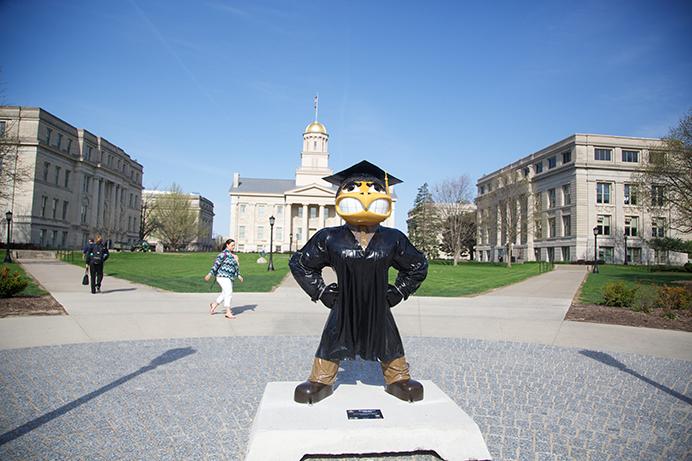Iowa’s public universities see improved graduation and retention rates despite COVID-19
Graduation and retention rates have increased or stayed consistent in the past year at the University of Iowa.
University of Iowa mascot Herky the Hawkeye goes back out On Parade for the 10th Anniversary of Herky on Parade on Monday, May 5, 2014.
February 24, 2021
The three regent-governed universities in Iowa have each seen improvement in retention for the 2020-21 academic year despite the COVID-19 pandemic causing financial hardships for students and their families.
Overall, the state Board of Regent universities saw a 2 percentage point increase in undergraduate second-year retention, rising from 86 percent to 88 percent, the highest it has ever been, for fall 2020, according to regent documents presented on Wednesday.
The University of Iowa’s second-year retention rate increased to 88 percent, Iowa State University’s increased to 89 percent, and the University of Northern Iowa’s increased to 86 percent.
For third-year retention, the UI’s rate improved to 79 percent, ISU’s rose to 82 percent, and UNI’s decreased from 75 percent to 74 percent, according to the documents.
The Board of Regents Associate Chief Academic Officer Jason Pontius told the regents on Wednesday this year’s graduation and retention rates are a story of improvement.
“It’s very difficult to move the needle for retention numbers,” Pointus said. “This is in part because there are many factors that influence a student’s decision to leave college, and many have nothing at all to do with academic ability, and yet we are seeing improvement in retention.”
Academic Support and Retention Director Mirra Anson said in an interview with The Daily Iowan there were many factors that influenced whether students returned to campus this academic year.
“It was surprising to see the rates trend that way,” Anson said.
She said funding from the CARES Act could have been a factor that influenced students’ return for classes this year. Her office moved some of the programs, such as supplemental instruction, online to accommodate for courses moving to virtual and hybrid formats, Anson said. The office also added a section to Success at Iowa, a first-year orientation virtual course, about how to succeed in a virtual learning environment, which included strategies for taking online courses, she said.
The regent universities have seen the “achievement gap” between white students and students who identify as an underrepresented minority narrow over time. According to the documents, the second-year retention rate for students who identify as racial/ethnic minorities has increased from 83 percent to 87 percent, 1 percentage point below the second-year retention rate for white students. The second-year retention rate for students who identify as underrepresented minorities rose from 82 percent to 85 percent, according to the documents.
Regarding four-year and six-year graduation rates for students who identify as a racial/ethinic minority or an underrepresented minority, a larger “achievement gap” exists. Four-year graduation rates for racial/ethnic minorities and underrepresented minorities are 42 percent and 41 percent, respectively, the graduation rate for white students is 54 percent, according to the documents.
The four-year and six-year graduation rates for the regent universities remained unchanged at 52 percent and 72 percent, respectively. According to the documents, the three-year graduation rate increased to 4 percent and the five-year graduation rate increased to 72 percent.
At the UI specifically, the four-year graduation rate stayed unchanged at 55 percent, the highest of all the universities, and the six-year graduation rate stayed at 72 percent, according to the documents.
ISU had a four-year graduation rate of 51 percent and a six-year graduation rate of 75 percent. UNI’s four-year rate decreased from 44 percent to 43 percent, and the six-year graduation rate dropped from 67 percent to 63 percent.
Anson said it’s unclear how the pandemic will impact the four-year and six-year graduation rates in the future. A concern is that students coming to college now or who came in during the fall who have had mainly virtual or hybrid instruction aren’t making connections with faculty and students to build support systems, she said.
Based on six-year graduation rate data, Pointus said it should be expected that the regent institutions will continue to see growth.
“Everything has been shaken now, I feel like, with COVID,” Anson said. “We know how important relationships are, how important engagement with faculty is, that belonging is important, and finding a community.”






